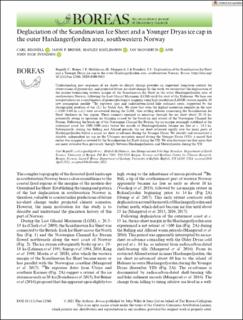| dc.description.abstract | Understanding past responses of ice sheets to climate change provides an important long-term context for observations of present day, and projected future, ice-sheet change. In this work, we reconstruct the deglaciation of the marine-terminating western margin of the Scandinavian Ice Sheet in the outer Hardangerfjorden area of southwestern Norway, following the Last Glacial Maximum (LGM) until the start of the Holocene. We base our interpretations on a combination of geomorphological mapping using high-resolution (LiDAR) terrain models, 68 new cosmogenic nuclide 10Be exposure ages and radiocarbon-dated lake sediment cores, supported by the stratigraphic position of the 12.1 ka Vedde Ash. We show that even the highest mountain summits in the area (˜1200–1400 m a.s.l.) were ice-covered during the LGM, thus settling debates concerning the Scandinavian Ice Sheet thickness in this region. These summits emerged as nunataqs through the ice sheet about 22–18 ka, potentially owing to upstream ice thinning caused by the break-up and retreat of the Norwegian Channel Ice Stream. Following the break-up of the Norwegian Channel Ice Stream, the ice margin seemingly stabilized at the outermost coast for 3500–5500 years before the mouth of Hardangerfjorden became ice free at c. 14.5 ka. Subsequently, during the Bølling and Allerød periods, the ice sheet retreated rapidly into the inner parts of Hardangerfjorden before a major ice sheet re-advance during the Younger Dryas. We identify and reconstruct a sizeable, independent ice cap on the Ulvanosa mountain massif during the Younger Dryas (YD), a massif that earlier was mapped as covered by the Scandinavian Ice Sheet during the YD. We also document ice-free areas that are more extensive than previously thought between Hardangerfjorden and Matersfjorden during the YD. | en_US |

